Cyanobacteria levels in Harare’s water supplies is a bio-index for bad governance
Introduction
The poor water supply to Harare’s citizens is not anything new. Reuters Thompson Foundation reporter Jeffrey Gogo reported in January 2016 that the city's health director, Prosper Chonzi, had declared, “six cases of typhoid have been confirmed, with more expected to emerge” adding, “The conditions on the ground - frequent water cuts and poor sanitation - are conducive to a typhoid outbreak…As long as there is no constant supply of water to residents, we will continue to have sporadic cases of such outbreaks."[1]
A 32-year-old nurse at Parirenyatwa Hospital, who did not want to be named, said, “I live in the townships, and there we do not have water four days of the week from 4am to 10pm, and no water at all for the other three days…When available, the water is visibly dirty, brownish or greenish in colour, and smells like raw sewage.”
At the time City officials attributed the problem to climate change and the third drought since 2013 with the city’s main reservoir, Lake Chivero, unable to keep up with water demand for domestic use and irrigation. Household water supply had been cut by 18 percent to 450 million litres a day, just over half of daily needs, leaving thousands of Harare residents without enough safe water for drinking and washing and they feared an impending epidemic, like the 2008-9 cholera crisis that originated in the capital, killing 4,000 people and affecting 100,000 more across the country.[2]
But water supply is only part of the problem. City spokesman Michael Chideme told the Reuters Thompson Foundation that the lake was also heavily polluted with raw sewage[3] and industrial chemical waste,[4] as well as fertiliser and pesticide run-off from urban farming.[5] He added that Harare now spends $4 million on chemicals and power each month to purify water - about $800,000 more than it would cost for less polluted water. “So, for us to treat water to required standards, the logical thing was to reduce the amount treated.”
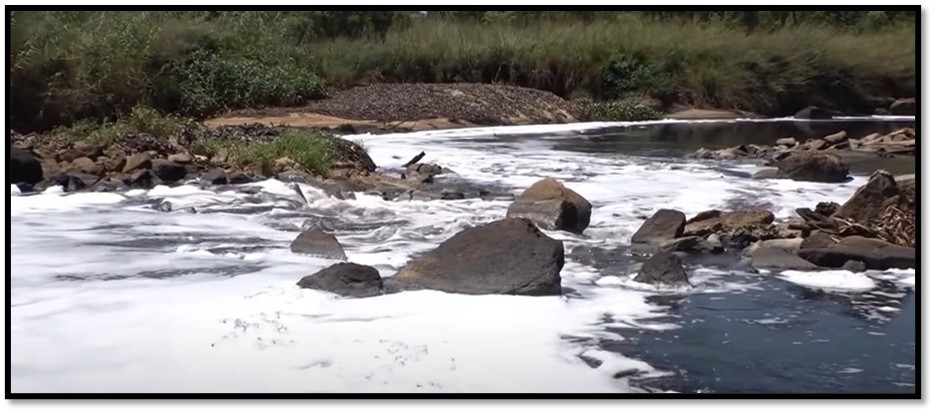
Al Jazeera: Raw sewage in the Mukuvisi river that is running into Lake Chivero
A History of the City of Harare’s water infrastructure
The Suburban newspaper carried a comprehensive article underlying Harare’s water and sewage problem. In the early 20th century city residents used the Mukuvisi, Umwindsi and Gwebi streams and wells until 1913 when the Cleveland Dam was built with an attendant water treatment plant.
The bigger Seke Dam was built on the Manyame river in the early 1930’s with a new water treatment plant on the Harare kopje. In the early 1950’s Lake McIlwaine (now Chivero) was built. Later in the 1980’s Morton Jaffray waterworks was added on the Manyame downstream of Seke with a design capacity of 614 million litres per day.
In 1974 the Prince Edward waterworks were added with additional capacity of 90 million litres per day with Harava Dam completed upstream of Seke in the same decade, their intended supply being the rapidly growing Chitungwiza and neighbouring St Mary’s and Zengeza 1, both of whom have expanded significantly since.[6]
Lake Darwendale (now Manyame) was completed in 1979-80 downstream of Chivero with a tunnel that brings water to Morton Jaffray waterworks.
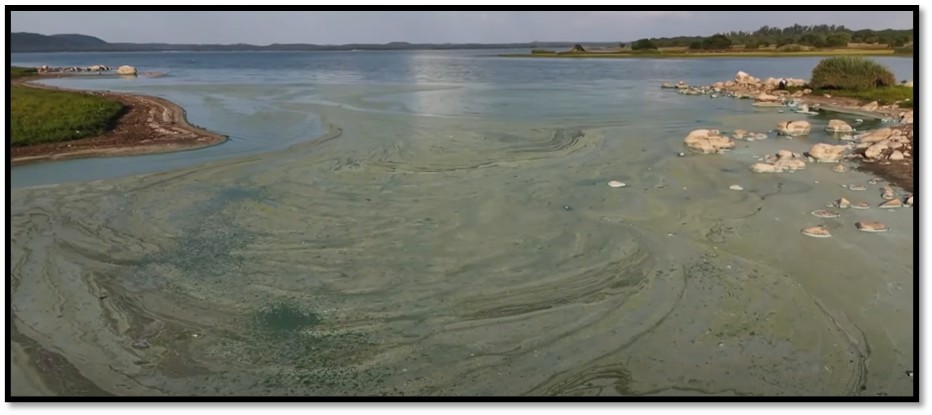
Al Jazeera: Cyanobacterial blooms are threatening Lake Chivero
The underlying problems for the City of Harare are these:
- The water supply is unable to cope with expanding demand. The population of Harare including Chitungwiza, Epworth, Norton and Ruwa has increased from 0.4 million in 1980 to over 2.0 million at the 2012 Census to an estimated over 4 million today (i.e. over ten times) If Morton Jaffray was producing at its design capacity of 614 million litres per day, in theory it could supply approximately 150 litres per day per person.[7]
- It is not just droughts and climate change making the problem. Unprocessed sewage, farm fertiliser run-off and industrial waste results in the rivers and lakes being increasingly choked by blooms of toxic cyanobacteria, revealing itself as blue-green algae, making the raw water unusable for human and wildlife consumption.
- However, the water supply system from the waterworks, that is the distribution, storage and reticulation network has not been expanded to meet the increased demand and worsened by ageing wastewater treatment facilities.
- City of Harare water bills are not being paid. City officials estimate that only 60 percent of the water supplied is being billed to customers. Of those billings only 50 percent of them are actually being paid (i.e. only thirty percent of the water supplied is being paid for, with seventy percent unpaid)[8]
- As a consequence of low revenues, City of Harare has insufficient funds to buy water treatment chemicals, to repair or replace pumps that break down, and repair, or expand the water distribution system that results in significant leakages.
- Finally, the cost of treating the raw water has been amplified by increased pollution in Lake Chivero caused by untreated sewage from broken sewers and non-functioning pump stations and industrial pollution being discharged into the streams that feed into Lake Chivero.

Water Research Foundation: an overabundance of phosphorous and nitrogen in the river system
The City of Harare is unable to cope with the problem
The combination of drought, ageing infrastructure, pollution and an ever-expanding population makes it almost impossible for city officials to adapt to the situation and a 2014 survey by the government and international aid agencies showed the number of Harare households with access to clean drinking water and sanitation had dived from 95 percent in 2009 to just below 40 percent in 2014. This despite the city sinking 240 boreholes in the worst-affected areas.[9]
Amkela Sidange, spokesperson for the Environmental Management Agency of Zimbabwe (EMA) said that in Zimbabwe about 415 megalitres of untreated sewage are being discharged into the environment daily. She added, the “city of Harare on its own ... contributes about 219 megalitres of raw and partly treated sewage that is discharged into the environment on a daily basis, and that goes to show how huge the crisis is.”[10]
Current Mayor of Harare Jacob Mafume partly blamed informal settlements for the crisis saying, “We have over 150,000 informal settlements, and these informal settlements do not have sewer reticulation systems. Therefore, their discharge is going straight into our water bodies.”[11]
In 2020, the then Mayor, Herbert Gomba, was forced to say in relation to the city’s water quality, “It’s safe, according to reports from our quality team…I am sure you are aware we are facing forex challenges and that the infrastructure is old and was never meant for the huge population we now serve. Again, we are owed a lot by our people, money which can be used to do more work if we are paid by all who consumed our water. We are working hard to pump more water through refurbishment of the infrastructure.”[12]
Many Harare residents drink only bottled water and water from boreholes. Yet poorer residents cannot afford bottled water and do not have access to borehole water. Global Press Journal correspondent Linda Mujuru interviewed Junior Buta who said the water supplied by the city is sporadic, available only every three or four days and often smells foul. “We use it to water our gardens, and once the water clears, we collect it in our bowls…Even after sitting for a day, we still notice visible dirt settling at the bottom.”[13] Buta collects her drinking water from neighbours who have a borehole – at a cost of US$1 for three buckets.
Harare is a city dependent on groundwater sources
The underlying geology of the city is mostly ‘hard rock’ basement geology with groundwater availability controlled by the presence of fractures.[14] Some suburbs have few fractures and bore drilling may be unsuccessful, or boreholes may only work for part of the year because of limited recharge through the fracture network. Droughts in the 1980’s and 1990’s resulted in widespread drilling of private boreholes that has resulted in some bore holes drying up due to over-pumping.
Groundwater contamination caused by poor sanitation has caused some boreholes to be condemned as seasonal cholera and typhoid outbreaks affect communities.[15]
Harare is situated on top of the watershed in the headwaters of its river systems with its still open spaces designated as wetlands - historically, construction was not permitted on wetlands as they are the city’s primary water source.[16]
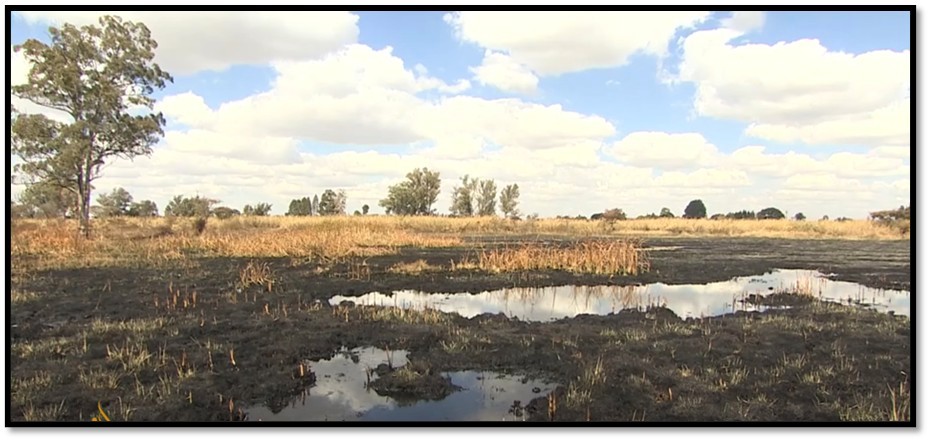
Al Jazeera: a typical view of a Harare wetland
Increasingly these wetlands are being encroached upon for residential buildings, shopping centres and churches. Often citizens suspect that city officials are bribed to turn a blind eye as corruption is pervasive throughout the economy from the very top to government and city officials. Residents of the city are outraged at the erosion of wetlands, but powerless to do anything about it.[17]
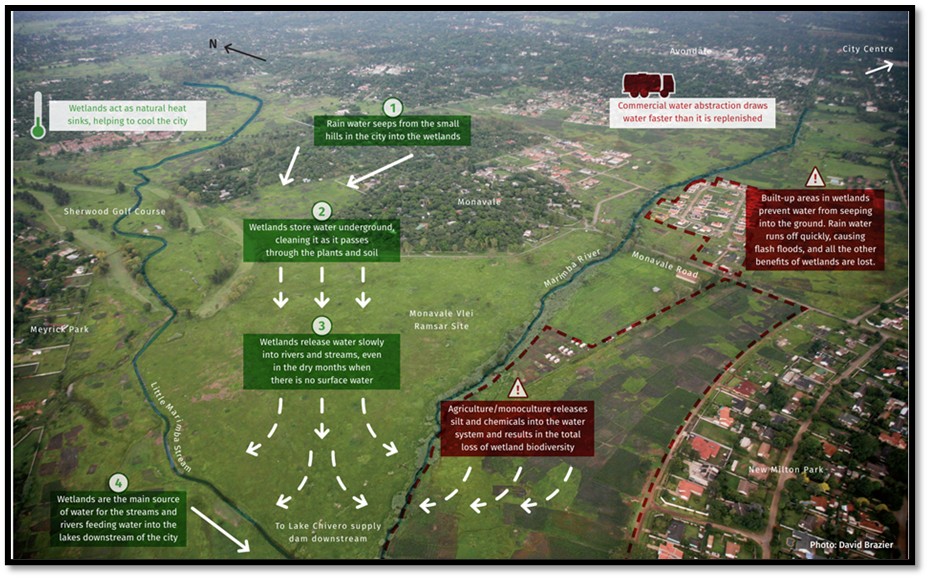
Birdlife Zimbabwe Graphic
Harare’s wetland natural filtration system is under threat. Wetlands are crucial to filtering out pollutants but are being damaged and destroyed to make room for construction to meet the city’s housing demands. Gary Stafford commented; “If the water is held there for a period of time in a wetland, the wetland cleans the water before it comes to the lake. Also, the wetland will release water over a long period of time so as City of Harare are taking water out, it is being replenished by the wetlands as clean water.”[18]
Harare residents voice outrage over sewage spilling into the Mukuvisi river
The result of these woes has been ever-increasing volumes of raw sewage being dumped into the Mukuvisi river that then finds its way into the City’s water supply at Lake Chivero.[19] The Herald Newspaper as early as 2017 reported the City’s Auditor-General, Mrs Mildred Chiri, saying, “The Firle sewer treatment plant has only two out of seven pumps working and the Crowborough sewer treatment plant is using one out of the four pumps…According to the management representations, the biological digesters[20] have not been functioning for about seven years.”[21]
In 2023, the Herald reported that more than 75 percent of the raw sewage being generated in Harare is finding its way into the streets, or the soils of the involved communities, or directly into Lake Chivero before it can be treated owing to the breakdown of the city’s sewerage infrastructure.[22]
However, as the report gave a figure of only 38 megalitres of sewage being treated each day from an estimated 330 megalitres, this actually represents over 88% not being treated.
Harare City waste water manager Engineer Simon Muserere said.” …All our treatment plants have a design capacity of 219.5 megalitres per day, but we only have a functional 38 megalitres per day. This is from our Unit 4 at Firle which treats 18 megalitres (ml) Unit 5C at Firle which treats 18ml, Hatcliffe treats 2,5 ml and Marlborough treats 7 ml…”
Engineer Muserere said the bulk of the uncollected sewage was from the southern incorporated areas (Chitungwiza, St Mary’s, Zengeza, Ruwa) which could not be connected to the sewer system at the moment. Besides broken sewer lines within the suburbs, he added the trunk sewer from Kuwadzana to Crowborough was also broken and discharging straight into Little Marimba River, as well as the stream crossings at Glen Norah.[23]
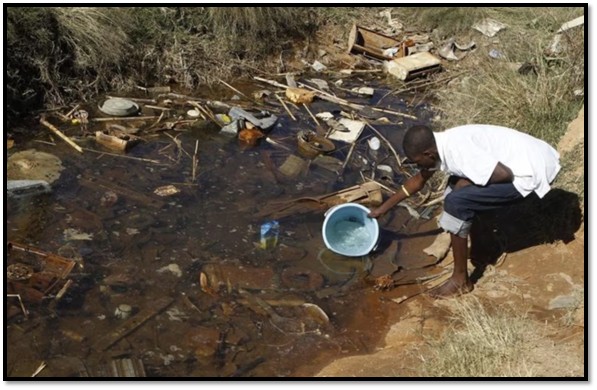
REUTERS/Philimon Bulawayo: Residents of Mabvuku fetch water from unprotected sources in July 2012
With so many water treatment pumps out of action close to 200 megalitres of sewage is going directly into Lake Chivero daily. Engineer Muserere added, “It also means treatment of water[24] becomes complex. We have a high cost of water treatment chemicals, and we will lose another 30 percent of water through backwashing and other losses at the treatment plant. So, what we then pump into the distribution system is also reduced.” He added, “This whole vicious cycle has to be broken somewhere, somehow. We need to respect the entire cycle of water. We should not only respect the clear water, but also the polluted water from the sewage treatment plants, the trunk sewers and also the bioreactor system in the treatment works that protects the city from all these contaminants.”[25]
Lake Chivero’s depth has decreased[26] from 28 meters (92 feet) to just 18 meters (59 feet) due to sediment buildup, partly from pollution.[27] Local residents say that for years, the city has been dumping raw and semi-treated sewage into the lake and the rivers that feed it.
The city of Harare spends between US$2.5 million and US$3 million every month on water purification — but these efforts appear to be far from effective. There has been talk of privatising the water treatment services, but In Johannesburg privatizing water services led to higher costs and access issues for low-income communities resulting in widespread protests. Reuben Akili, Director of the Combined Harare Residents Trust said the whole issue is a cop-out by the city of Harare as private companies undermine accountability.[28]
The result of this water contamination is cyanobacteria
The pollution from the raw sewage into Lake Chivero is causing an upwelling in cyanobacteria that poses a great health risk to humans and wildlife.[29] Already Zimparks[30] has banned all fishing within the lake, where thousands of fish have already died, and some of the wildlife within Lake Chivero Recreational Park, including four rhinos and three zebras. Tinashe Farawo, Zimparks spokesperson said, “We are not only losing the rhinos, but [we] also lost some zebras, wildebeest and some birds.” He added, “Heavy contamination results in cyanobacteria. The cyanobacteria causes a fertile ground for algae growth that takes oxygen from the water and is harmful to animals.”[31]
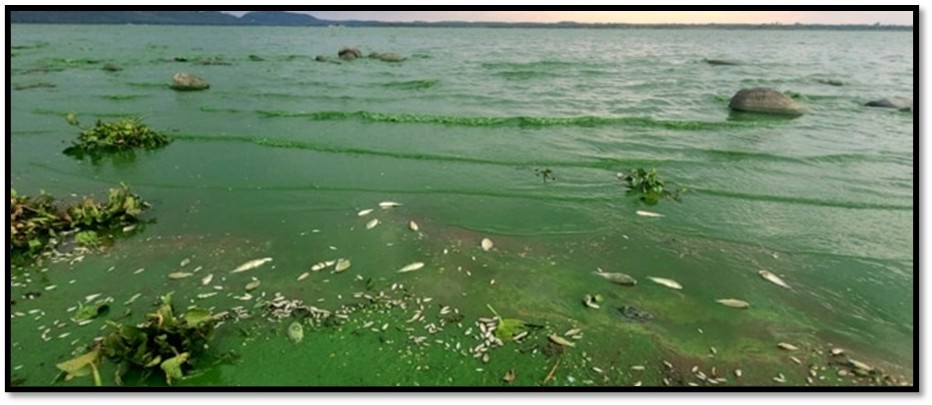
Columbus Mavhunga (VOA) pollution has killed the fish in Lake Chivero
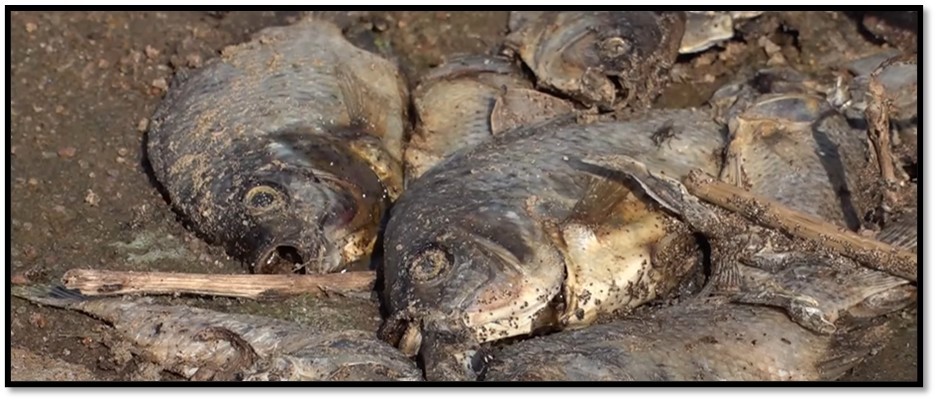
Al Jazeera: Commentator: As well as causing the current outbreaks of water-borne diseases, the pollution is killing endangered wildlife and scientists fear that if nothing is done soon, the damage could be irreversible.
In a recent Daily Maverick article[32] Don Pinnock writes that Cyanobacteria are probably the most numerous creatures to have ever existed on Earth and whilst they’re good for making oxygen, are otherwise bad news for most life forms. In South Africa, as well as Zimbabwe, through neglect of the water systems, they’re on a feeding frenzy.
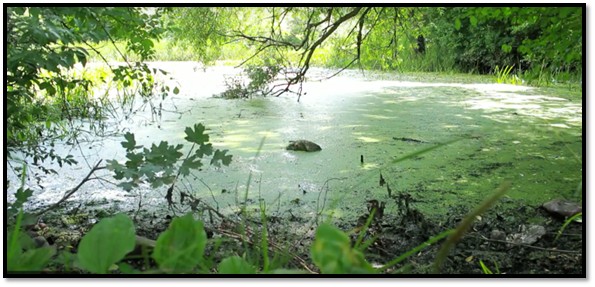
Water Research Foundation – water contaminated with cyanobacteria
Cyanobacteria are not algae, although a lot of people think they are, they are bacteria and composed of single-cell, microscopic, photosynthetic aquatic organisms that are ancient, ubiquitous and naturally occurring. They grow out of control when there is a lot of light and nutrients. The nutrients they need that produce good growing conditions for cyanobacteria are typically phosphorus and nitrogen.[33]
In drinking water, they create a bad taste and smell and they produce compounds that are cyanotoxins that can produce kidney and liver (hepatotoxins) and nervous system problems (neurotoxins) The cyanobacteria produce cyanotoxins; some are extracellular toxins (they come out of the cell into the water) and others are intracellular toxins (they remain within the cell)
The problem for a water treatment plant is that extracellular toxins are treated with oxidants such as chlorine, ozone or permanganate and intracellular toxins need to be removed with the cyanobacteria themselves, or as the cyanobacteria start to burst and die, they re-release the cyanotoxins into the water treatment plant and that’s the challenge.
What Cyanobacteria does
The blue-green algae blooms they create spread across the water surface, blocking out the sunlight and depleting the oxygen levels in the water.[34] Pinnock writes, “The result is a catastrophic disruption of aquatic ecosystems and a threat to public health. Drinking or even coming into contact with cyanobacteria-infested water can cause severe health problems, from skin rashes and respiratory issues to liver and neurological damage”[35] and he cites Lake Chivero as an extreme example.
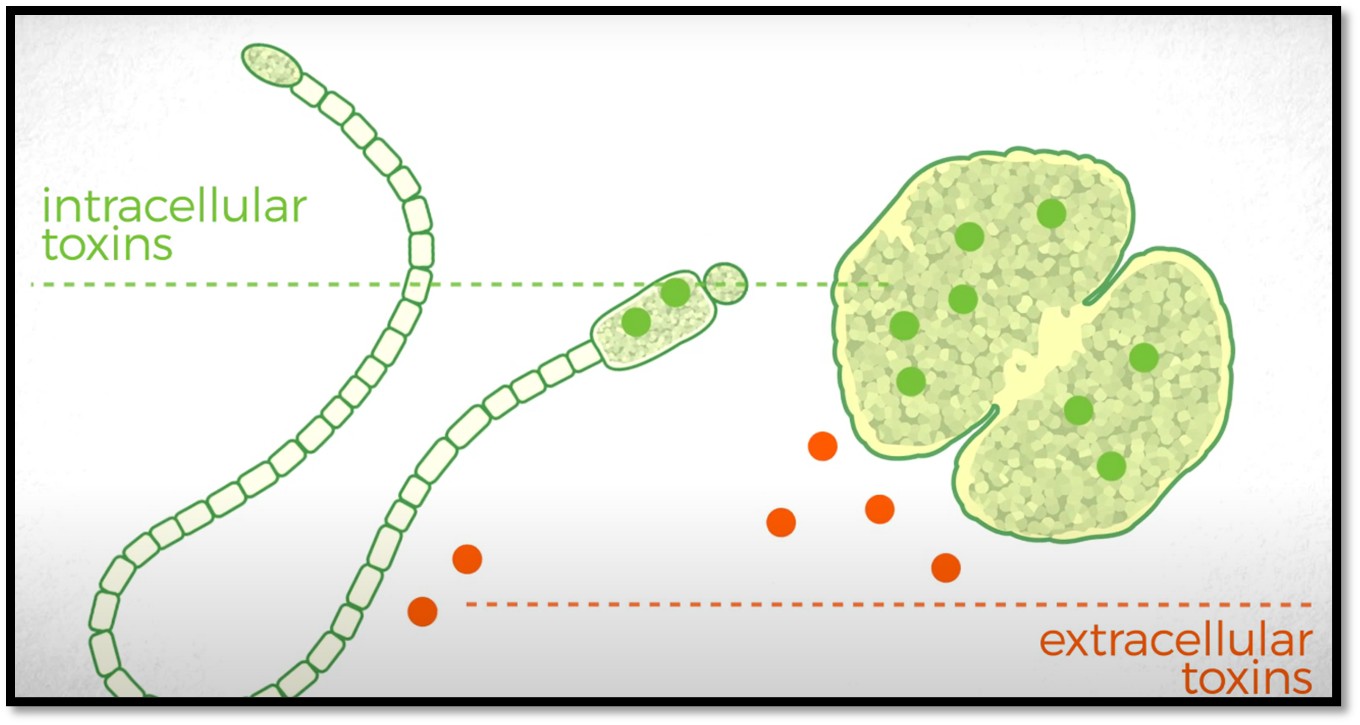
Water Research Foundation – graphic of cyanobacteria toxin types

Water Research Foundation – microscopic view of cyanobacteria cells
The most important factor in fighting cyanobacteria is to solve the water source problem so that there is less impact on the water treatment side of things. Some scientists advocate introducing oxygen into water so that beneficial algae and zooplankton can outcompete the cyanobacteria, but this process does not remove, “the toxic chemicals or heavy metals contained in domestic / industrial effluent overflowing into the environment from broken or dysfunctional wastewater treatment works.”[36]

Water Research Foundation – cyanobacteria evident as blue-green algae blooms
Harare faces a serious clean drinking water challenge due to pollution, primarily from industrial waste and raw sewage entering Lake Chivero, the city's main water source, and insufficient water treatment infrastructure.[37]
Here's a more detailed summary explanation of Harare’s recurring pollution problems:
Pollution Sources:
Industrial Waste and Sewage: Industrial waste and raw sewage are discharged into tributaries and streams that feed Lake Chivero, the city's primary water source.
Poor Sanitation and Waste Management: Inadequate sanitation and waste management practices contribute to groundwater contamination and further complicate the water quality issue.
Consequences:
Water Hyacinth Growth: Pollution from streams draining the Harare area, like the Mukuvisi and Nyatsime rivers, has led to a significant water hyacinth problem in Lake Chivero.
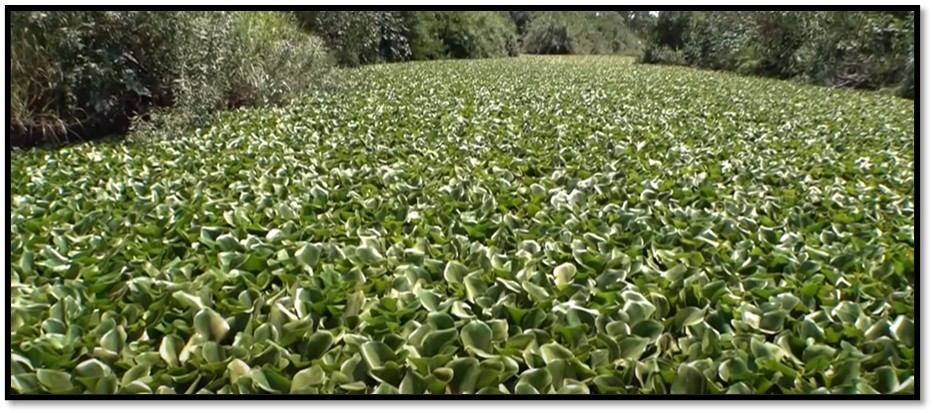
Al Jazeera: water hyacinth chokes Lake Chivero’s waterways
Water Quality Issues: The pollution in Lake Chivero poses a threat to the efficient operation of the Morton Jaffray Waterworks and the quality of drinking water supplied to the city.
Health Risks: The presence of cyanobacteria toxins in the water supply can lead to health problems, including liver and central nervous system diseases.
Outbreaks: Seasonal cholera and typhoid outbreaks are a concern, further exacerbated by poor sanitation and water quality.
Examples of Water Quality Concerns:
Residents have reported tap water that is "dirty, smells of sewage and often pitch-black coloured."
A study by Nanotech Water Solutions concluded that the health of four million Harare residents may be endangered by the provision of water containing cyanobacteria toxins.
- The situation requires urgent attention and action to address the pollution and ensure access to safe drinking water.[38]
- Upgrading the water infrastructure in Harare and surrounding areas is crucial.
- Implementing legal and other reforms to ensure the full promotion, protection, and enjoyment of the right to water is necessary.
- Taking steps to reduce corruption and ensure transparency and accountability in water and sewage services is essential.
References
Don Pinnock. 21 Mar 2025. The Daily Maverick. How cyanobacteria and government inaction are threatening the country’s water supply. https://www.dailymaverick.co.za/article/2025-03-21-how-cyanobacteria-and-government-inaction-are-threatening-the-countrys-watersupply/p
Jeffrey Gogo. Thomson Reuters Foundation. 29 Jan 2016. Typhoid-hits Harare as water crisis fuels fears of new Epidemics: https://www.reuters.com/article/world/typhoid-hits-harare-as-water-crisis-fuels-fears-of-new-epidemics-idUSKCN0V71EW/
Suburban. 11 Oct 2024. History of the City of Harare Water Supply: Facts about current woes https://www.suburban.co.zw/history-of-the-city-of-harare-water-supply-facts-about-current-woes/
Suburban. 20 Dec 2024. Outrage over Lake Chivero pollution
https://www.suburban.co.zw/outrage-over-lake-chivero-pollution/
Abigail Mawonde. Herald Online. 3 July 2017. Council Sewer Systems Down. https://www.heraldonline.co.zw/council-sewer-systems-down/
Dyton Mupawaenda. Herald. 16 Nov 2023. 75pc effluent flows into Lake Chivero. https://www.heraldonline.co.zw/75pc-effluent-flows-into-lake-chivero/
Water Research Foundation. Video: Understanding Cyanobacteria and Cyanotoxins
Dr Bentje Brauns, Dr Daniel Lapworth, Professor Alan MacDonald. British Geological Survey. 31 May 2023. Harare’s clean drinking water challenge. https://www.bgs.ac.uk/news/harares-clean-drinking-water-challenge/
Birdlife Zimbabwe. https://www.birdlifezimbabwe.org/Attachments/Wetland%20Ecosystems%20Brochure.pdf
Columbus Mavhunga. Sewage-polluted lake water kills rhinos, other wildlife in Zimbabwe. Voice of America. 18 Dec 2024. https://www.voanews.com/a/sewage-polluted-lake-water-kills-rhinos-other-wildlife-in-zimbabwe/7905685.html
Linda Mujuru. Global Press Journal. Zimbabwe’s Capital Contaminated Its Water. Now, Residents Must Pay to Use It. 23 Mar 2025. https://globalpressjournal.com/africa/zimbabwe/zimbabwes-capital-contaminated-water-now-residents-must-pay-use/
Nyasha Chingono. The Guardian Org. 22 Jan 2020. Millions at risk after toxins found in Harare water supply, study finds. https://www.theguardian.com/global-development/2020/jan/22/millions-at-risk-after-toxins-found-in-harare-water-supply-study-
Mmalegabe Motsepe. Al Jazeera YouTube video. https://www.youtube.com/watch?v=SW4dm1iUBVA#:~:text=The%20main%20supply%20of%20drinking%20water%20in,cannot%20be%20fixed%20by%20basic%20water%20treatments
Notes
[1] Reuters: Typhoid hits Harare
[2] Ibid
[3] A 2014 ministerial committee report blamed Harare for pumping 3,885 megalitres of raw sewage into Lake Chivero each month.
[4] The same 2014 report said industrial and mining companies were discharging harmful chemical waste into the Manyame and Mukuvisi rivers and other tributaries that feed into the lake, degrading water resources and corroding pipelines
[5] The pollution has pushed the Lake Chivero’s pH levels above 8, an alkaline state that increases water treatment costs.
[6] Daina Mudimbu, geoscientist agrees the combined waterworks design capacity of 904 megalitres per day (Morton Jaffray 614 ML plus Prince Edward 90 ML) but this is their theoretical capacity of course. He estimates there is an estimated 800 – 1,300 megalitre estimated demand for water (Article – Harare’s clean drinking water challenge)
[7] Suburban Newspaper, 11 Oct 2024
[8] Ibid
[9] Typhoid hits Harare, as water crisis fuels fears of new epidemics
[10] Sewage-polluted lake water kills rhinos, other wildlife in Zimbabwe
[11] Sewage-polluted lake water kills rhinos, other wildlife in Zimbabwe
[12] Millions at risk after toxins found in Harare water supply, study finds
[13] Zimbabwe’s Capital Contaminated Its Water. Now, Residents Must Pay to Use It
[14] Harare’s clean drinking water challenge
[15] Harare’s clean drinking water challenge
[16] Birdlife Zimbabwe
[17] Amongst the comments to the Suburban Newspaper article of 20 Dec 2024 this one from Thando Mathe: “Mayor Matthew Mafume said informal settlements are to blame. Also mentioned the need to expand the city's reticulation network, but didn't explain why they pump raw sewage into the river like you report. We heard that EMA has legal power to issue EPO but hasn't. Why?” and this from Tendai Livingstone, “The city of Harare and local government must take immediate action to address this crisis. We are on the brink of a cholera and typhoid outbreak which would put countless lives at risk.”
[18] Gary Stafford is the owner of Kuimba Shiri Bird Sanctuary on the eastern shore of Lake McIlwaine – it’s well worth visiting
[19] Suburban Newspaper, 20 Dec 2024
[20] Biological digesters are used for decomposing sludge that is produced from the sewer treatment plants.
[21] Herald Online 3 July 2017
[22] Herald 16 Nov 2023
[23] Anyone using these stream sources is risking being contaminated with E. coli or other coliforms that cause diarrhoeal diseases.
[24] At Morton Jaffray Water Works when drawn from the lake.
[25] Herald Newspaper, 16 Nov 2023
[26] The EMA states Lake Chivero’s capacity has shrunk by 20 percent (article - Typhoid hits Harare…)
[27] Zimbabwe’s Capital Contaminated Its Water. Now, Residents Must Pay to Use It.
[28] Ibid
[29] The Minister for Health and Child Care Dr Mombeshora has called on the government to come in when City Council was struggling to address these challenges, but his call is unlikely to be heeded by a ZANU-PF government that is struggling with succession problems
[30] Sewage-polluted lake water kills rhinos, other wildlife in Zimbabwe
[31] Tinashe Farawo, Zimbabwe Parks Spokesperson
[32] how-cyanobacteria-and-government-inaction-are-threatening-the-countrys-watersupply
[33] Phosphorous and nitrogen, usually the result of raw sewage or agricultural chemicals runoff create nutrient-rich water
[34] One reason cyanobacteria are more difficult to control than traditional algae is that they rise during the day to capture sunlight at the water surface and sink at night to absorb the nutrients. This constant cycling means that conventional treatments, such as applying chemical algaecides, often fail to address the root cause of the problem.
[35] How cyanobacteria and government inaction are threatening the country’s water supply
[36] How cyanobacteria and government inaction are threatening the country’s water supply
[37] Suburban Newspaper, 11 Oct 2024
[38] The British Geological Survey (BGS) is collaborating with the University of Zimbabwe (UZ) in a study to assess access to clean drinking water sources across the city of Harare and the impact of recent donor-led upgrades to groundwater supply systems (article - Harare’s clean drinking water challenge)
